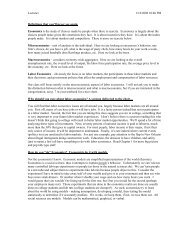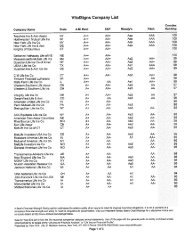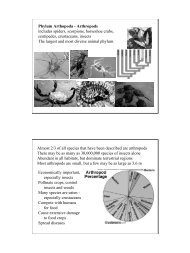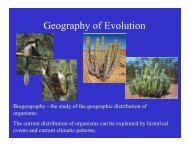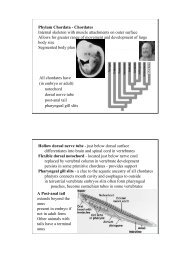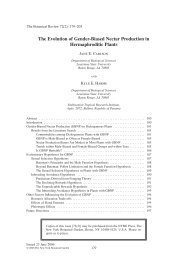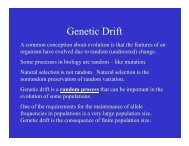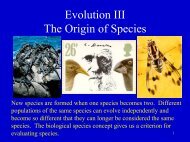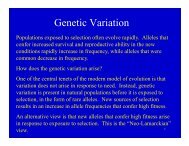Create successful ePaper yourself
Turn your PDF publications into a flip-book with our unique Google optimized e-Paper software.
Reproduction in <strong>Fungi</strong>• Differ from most animals and plants in that eachcompartment of hypha can contain one, two or morenuclei– monokaryotic - each compartment has a single nucleus– dikaryotic - two distinct nuclei within each hyphaecompartment• Possible for many nuclei to intermingle in commoncytoplasm of fungal mycelium which can lack distinctcells– heterokaryotic – dikaryotic or multinucleate hypha hasnuclei from genetically distinct individuals– homokaryotic – hyphae whose nuclei are genetically4similar to one another
3.2 Forestation projects3.2.1 Large scale reforestationFFF launched large scale reforestation program in 2004 with a view toexpanding forest coverage in five Kebeles of Lalibela town and fiveKebeles of Bugena Woreda. Under this project, FFF identifies degradedareas, makes them green and eventually hands over them to thecommunity or concerned government bodies.The project activity includes, among others, site selection, soil and waterconservation measures, hill side terracing, building of micro catchmentsand trenches, planting of indigenous and ornamental trees as well asfodder development.Forest developed by FFF at Medge (outskirts of Lalibela town)3.2.2 Nursery DevelopmentUnder this project, FFF helps the expansion of nurseries for theproduction of seedlings. Currently, seedlings are produced in nurserieslocated at Shemsheha, Simeno and Kenkenit areas. Seedlings are5
Nmeiosis2NN7
N+Nnuclear fusion2NmeiosisdikaryonN8
Fungal EcologyFeeding - saprobes - feed on dead or living material - secretedigestive enzymes and absorb products of digestionsome are important decomposerscan digest lignin and cellulose of woodsome are parasitic on living organismsathlete’s foot, ringworm, corn smut, rustssome are predatory - some can anesthetize and consumeroundworms (our local oyster mushroom)some have mutualistic relationships with other organismslichen = fungus + green algafungus provides alga with some nutrientsneeded for photosynthesis - alga providescomplex organic nutrients to fungusmicorhizzal fungi - associate with plant roots andabsorb nutrients from soil to aid plant9
There are four major groups of fungiChytridiomycotaZygomycotaBasidiomycotaAscomycota10
Phylum Chytridiomycota - 1000 speciesaquatic, flagellated fungi– most closely related to ancestorsof all fungi– gametes are flagellated– has well developed sporophyte(diploid) stage11
e.g. Allomyces - sporic meiosis with multicellular haploid stage(gametophyte) and multicellular diploid stage (sporophyte)12
Phylum Zygomycota – 1050 speciesBread molds and relativesSexual and asexual reproduction commonHyphae without septa, except for separation of reproductivestructuresHas short diploid stage(zygosporangium)13
e.g. Rhizopus - zygotic meiosis - multicellular haploid stageonly14
Phylum Basidiomycota – 22,000 speciesmushrooms, toadstools, rusts, smutsmany species eatenmany poisonous or semi-poisonous specieshas well developeddikaryotic stagethe basidiocarp (mushroom)carries basidia on gills or inporesnuclei fuse within basidiaand then producebasidiospores by meiosis15
Phylum Ascomycota – 45,000 species –Most yeasts, truffles, morelsGreat diversity - includes many plant parasites –e.g. Dutch elm disease and chestnut blightSometimes called cup fungi because of the shapeof their reproductive structuresHas well developeddikaryotic stageThe ascocarp carries asciwithin cupsNuclear fusion occurs withinascus, meiosis followsproducing ascosporesSome species lack a sexualstage (e.g. Penicillium)18
•Yeasts– unicellular - most reproduction is asexual and takesplace by cell fission or budding• ferment carbohydrates - produce ethanol as byproduct• play a leading role in genetic research21
Ecology of <strong>Fungi</strong>• <strong>Fungi</strong> are saprobes - heterotrophs that secretedigestive enzymes and absorb products ofdigestion.• some are important decomposerscan digest lignin and cellulose of wood• some are parasitic on living organismsathlete’s foot, ringworm, corn smut, rusts22
•some are predatory - some can anesthetize andconsume roundworms (our local oyster mushroom)•some have mutualistic relationships with other organismslichen = fungus + green algafungus provides alga with some nutrientsneeded for photosynthesis - alga providescomplex organic nutrients to fungusmicorhizzal fungi - associate with plant roots andabsorb nutrients from soil to aid plant23
Fungus is usually ascomyceteSpecialized hyphae penetratephotosynthetic cells andtransfer nutrients.Lichens are able to invadeharsh terrains and climates.They are extremely sensitiveto pollutants24
About 90% of all kinds of vascular plants are involved inmutualistic symbiotic relationships (mycorrhizae).<strong>Fungi</strong> are able to extract raw nutrients from soil that plants can’tarbuscular mycorrhizae - fungal hyphae penetrate outer cellsof plant rootectomycorrhizae - hyphae surround, but do not penetrate, cellwalls of roots25
•A range of mutualistic fungal-animal symbioses has beenidentified.• ruminants• leaf-cutter ants• termites27
Chytridiomycosis - emergent infectious disease in amphibianschytrid Batrachochytrium dendrobatidisAflatoxins - carcinogeniccompounds produced bystrains of Aspergillus flavusgrows on corn, peanuts,cotton seeds28




